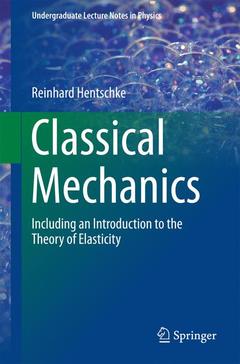Classical Mechanics, 1st ed. 2017 Including an Introduction to the Theory of Elasticity Undergraduate Lecture Notes in Physics Series
Auteur : Hentschke Reinhard

This textbook teaches classical mechanics as one of the foundations of physics. It describes the mechanical stability and motion in physical systems ranging from the molecular to the galactic scale. Aside from the standard topics of mechanics in the physics curriculum, this book includes an introduction to the theory of elasticity and its use in selected modern engineering applications, e.g. dynamic mechanical analysis of viscoelastic materials. The text also covers many aspects of numerical mechanics, ranging from the solution of ordinary differential equations, including molecular dynamics simulation of many particle systems, to the finite element method. Attendant Mathematica programs or parts thereof are provided in conjunction with selected examples. Numerous links allow the reader to connect to related subjects and research topics. Among others this includes statistical mechanics (separate chapter), quantum mechanics, space flight, galactic dynamics, friction, and vibration spectroscopy. An introductory chapter compiles all essential mathematical tools, ranging from coordinates to complex numbers. Completely solved problems and examples facilitate a thorough understanding of the material.
Mathematical Tools.- Laws of Mechanics.- Least Action for One Coordinate.- Principle of Least Action.- Integrating Equations of Motion.- Rigid-Body Motion.- Canonical Mechanics.- Many-Particle Mechanics.- Theory of Elasticity.
Reinhard Hentschke studied physics at the University of Osnabrück, Germany. He received his Ph.D. from the University of Maine, USA, with a thesis entitled “Application of Conformal Invariance to the Investigation of Second Order Surface Phase Transitions”. After a stay as a visiting scientist at the Department of Chemistry, Baker Laboratory, Cornell University, he worked as a postdoc at the Department of Chemistry, Brandeis University. Returning to Germany he joined the Max-Planck Institute for Polymer Research as a staff scientist. After obtaining his Habilitation in Physical Chemistry at the Department of Chemistry, Gutenberg University, Mainz, he moved to Wuppertal, where he is a professor in Physics at the Bergische Universität.
His research interests have frequently straddled the boundary between physics and chemistry. Early work as a Diplom and Ph.D. student has focused on surface physics, dealing with topics in molecule/ion-surface collisions and surface phase transitions. During his postdoctoral years the focus shifted to theoretical physical chemistry of reversible molecular aggregation as found in micellar and protein systems and the attendant liquid crystalline phase behavior. As a scientist at the Max-Planck Institute for Polymer Research he has concentrated on computer modelling of polymers.
Subsequent work has been a synthesis of these earlier fields. His group has concentrated on (a) the theoretical investigation of sorption in polymer networks, using computer simulation methods and lattice theory; (b) reversible self-assembly and phase behavior of equilibrium polymers, using again a combination of computer simulation and analytical theory; (c) dielectric properties in conjunction with the structural phase behavior of dipolar fluids; (d) the development of computer algorithms for molecular modelling. Recently he has become interested in theoretical problems encountered in elastomer technology.
Date de parution : 01-2017
Ouvrage de 380 p.
15.5x23.5 cm
Thème de Classical Mechanics :
Mots-clés :
Normal Mode Analysis; Stability Analysis; Molecular Dynamics Simulation; Rotation Curve; Sling-Shot Effect; Mechanics textbook; Elasticity Theory; Finite Element Method; Dynamic Mechanical Analysis; Storage Modulus; Laws of Mechanics; Equations of Motion; Canonical Mechanics; Many-Particle Mechanics



